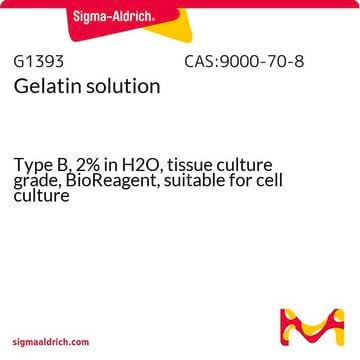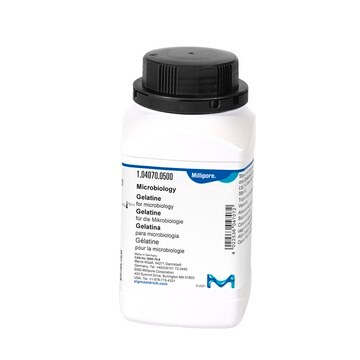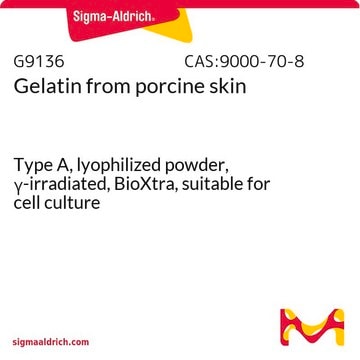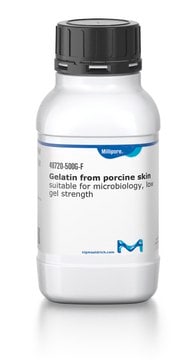The bulk density of this product is not determined.
G9382
Gelatin from bovine skin
gel strength ~225 g Bloom, Type B
Sinónimos:
Bovine gelatin
Seleccione un Tamaño
56,70 €
Seleccione un Tamaño
About This Item
56,70 €
Productos recomendados
origen biológico
bovine skin
Nivel de calidad
tpo
Type B
Ensayo
≥95% protein basis (biuret)
Formulario
powder
técnicas
ELISA: suitable
cell culture | mammalian: suitable
immunocytochemistry: suitable
western blot: suitable
solubilidad
H2O: soluble 50 mg/mL
¿Está buscando productos similares? Visita Guía de comparación de productos
Componentes
Precaución
Nota de preparación
Código de clase de almacenamiento
11 - Combustible Solids
Clase de riesgo para el agua (WGK)
nwg
Punto de inflamabilidad (°F)
Not applicable
Punto de inflamabilidad (°C)
Not applicable
Equipo de protección personal
Eyeshields, Gloves, type N95 (US)
Elija entre una de las versiones más recientes:
Certificados de análisis (COA)
¿No ve la versión correcta?
Si necesita una versión concreta, puede buscar un certificado específico por el número de lote.
¿Ya tiene este producto?
Encuentre la documentación para los productos que ha comprado recientemente en la Biblioteca de documentos.
Los clientes también vieron
-
What is the bulk density of this product
1 respuesta-
¿Le ha resultado útil?
-
-
What is the molecular weight of this Gelatin?
What is the molecular weight of this Gelatin?
1 respuesta-
The molecular weight of this product has not been evaluated, However, the molecular weight is closely related to the Bloom Number. The estimated ranges are as follows:
Bloom Number Average Molecular Mass (Da)
50−125 (Low Bloom) 20,000−25,000
175−225 (Medium Bloom) 40,000−50,000
225−325 (High Bloom) 50,000−100,000Please see the link below to review the general datasheet for Gelatin:
https://www.sigmaaldrich.com/deepweb/assets/sigmaaldrich/product/documents/333/625/g9382pis.pdf¿Le ha resultado útil?
-
-
How to sterilize 2% solution?
1 respuesta-
This item can be sterilized by autoclaving at 121°C, 15 psi for 30 minutes.
¿Le ha resultado útil?
-
-
Which is the molecular weight?
1 respuesta-
The Bloom number or gel strength of this product is ~225 g Bloom. The average molecular mass of 175-225 g Bloom (Medium Bloom) products is 40,000-50,000 Da. The average molecular mass of 225-325 g Bloom (High Bloom) products is 50,000-100,000 Da. Therefore, this product is expected to have a molecular weight of approximately 50 kDa.
For more information please view the product data sheet: https://www.sigmaaldrich.com/deepweb/assets/sigmaaldrich/product/documents/187/614/g6650-et-al-pis-ms.pdf
¿Le ha resultado útil?
-
-
Is this made from skin from a cow which was killed for the food chain?
1 respuesta-
All information that is shared regarding source can be found on a lot-specific Certificate of Origin (CofO, COO) for this product.
¿Le ha resultado útil?
-
-
What is Product G9382, Gelatin from bovine skin, soluble in?
1 respuesta-
Gelatin is soluble in glycerol and acetic acid, and more soluble in hot water than in cold water. We test the solubility of gelatin in water at 50 mg/mL (with heat).
¿Le ha resultado útil?
-
-
What is the Department of Transportation shipping information for this product?
1 respuesta-
Transportation information can be found in Section 14 of the product's (M)SDS.To access the shipping information for this material, use the link on the product detail page for the product.
¿Le ha resultado útil?
-
-
What is a Bloom number, and how does it correlate with the molecular weight?
1 respuesta-
The Bloom number is indicative of gel strength. The Bloom number is the amount of pressure, in grams, required to break the surface of a 6.67% gel. The general rule of thumb in regards to an average molecular weight: High Bloom (225-325) = 50,000-100,000; Medium Bloom (175-225) = 40,000-50,000; Low Bloom (50-125) = 20,000-25,000. Product G9382 is a high Bloom preparation of approximately 225 Bloom.
¿Le ha resultado útil?
-
-
What is the difference between type A and type B gelatin?
1 respuesta-
Type A gelatin is derived from acid-cured tissue whereas Type B gelatin is derived from lime-cured tissue. Type A gelatin has about 78-80 millimoles of free carboxyl groups per 100 g of protein and a pI of 7.9-9.0. Type B has 100-115 millimoles of free carboxyl groups per 100 g of protein and a pI of 4.7-5.2.
¿Le ha resultado útil?
-
-
What is the isoelectric point (pI) for Product G9382, Gelatin from bovine skin?
1 respuesta-
The pI for Product No. G9382 is typically in the range of 4.7 - 5.0.
¿Le ha resultado útil?
-
Filtros activos
Nuestro equipo de científicos tiene experiencia en todas las áreas de investigación: Ciencias de la vida, Ciencia de los materiales, Síntesis química, Cromatografía, Analítica y muchas otras.
Póngase en contacto con el Servicio técnico















